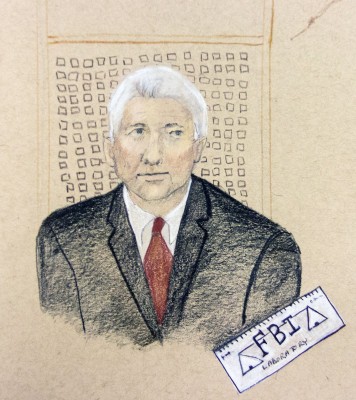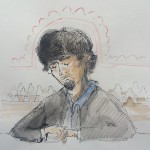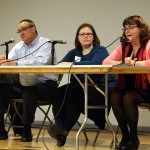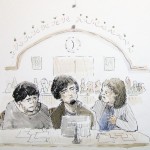As the trial for Dzhokhar Tsarnaev continued, the defendant sat with his hands cupped over his mouth and nose as his lawyers exchanged comments around him. The evidence in Thursday’s trial focused on connecting Tsarnaev to the bombs that were detonated in Watertown and on Boylston Street at the Boston Marathon finish line in April 2013.

Tsarnaev, a 21-year-old former University of Massachusetts Dartmouth student, is accused of placing two bombs at the finish line of the Boston Marathon on April 15, 2013, killing three people and injuring more than 260. He has pled not guilty to the 30 counts he has been charged with.
The first witness called was David McCollam, FBI chemist forensics examiner of the Scientific Explosives Unit. McCollam was the first of two witnesses to testify that the evidence collected at the two blast sites on Boylston Street and the one in Watertown showed evidence of a home-manufactured pyrotechnic explosion.
McCollam said his unit was engaged to determine the composition of the explosives.
“We analyze chemicals to test for explosive capability to arrive at a conclusion as to whether an explosive device was used, and if so, what type of device it was,” he said. “The evidence came in, there were many many pieces, over 300 pieces, swabs, big pieces of metal fragment, and you could see black material, residue that was left behind.”
McCollam said fireworks are a commonly accessible and cheap way to attain the “bulk material,” a pyrotechnic mixture for an improvised explosive device (IED), a homemade bomb.
The chemical signatures of the residues found at the blast sites were consistent with the residues found on latex gloves left in the Honda CR-V, which Tsarnaev abandoned in Watertown.
The second witness, Edward Knapp, supervisory special agent with the FBI, specializing in special-agent bomb technics, said intact fireworks and identical chemical residues were also found in a drawer in Tsarnaev’s dorm room at UMass Dartmouth.
Knapp explained the construction and the functionality of the three bombs detonated. The battery, receiver and transmitter came from basic radio-controlled cars — children’s toys.
The bombs detonated on the Marathon route and in Watertown were detonated remotely. The initiation of the bombs, as Knapp said, was a multistep process.
“We found an illuminated toggle switch, which sometimes you refer to as an arming switch. The toggle switch was used to break the circuit,” he said.
Knapp said the toggle switch is within the device itself and had to be initiated before the bomb could be detonated.
“Someone would have had to open it up, and initiate the switch, and reseal it so the substances are confined enough to build up pressure,” he said.
Additionally, all components of the bomb were “commonly available and commercially manufactured,” said Knapp.
The prosecution presented an article found in Tamerlan Tsarnaev’s house from Inspire magazine, a publication produced by al-Qaeda in the Arabian Peninsula. The article was entitled “Make a bomb in the kitchen of your Mom” and detailed how to make an improvised explosive device from an iron pipe. It had pictures and step-by-step instructions. The article advised that putting spherical metal pellets would inflict the most damage and that small nails could be used as an alternative. It suggests placing the bomb in a crowded area.
The jury and observers in the court shifted nervously, as the witness read the article to the courtroom. Knapp himself, a former U.S. Navy seal, slowed and shook his head, his voice breaking, as he read the disclaimer at the end of the article.
“We ask Allah to assist our brothers in targeting His enemies and we ask Allah to grant us victory,” he read.
The trial continued after a break for lunch with the presentation of two mock-ups of the pressure cooker bombs Tsarnaev used in both the marathon and the shootout with police in Watertown that occurred days later.
Knapp first presented the pressure cooker bomb used at the finish line of the Marathon. He said the inner contents of the bomb included fusing, an electronic speed controller, a toggle switch and various explosives, including BBs and small steel nails.
He then placed the pressure cooker into a backpack, and explained that the weight ranged from eight to 15 pounds, when full of explosives, and passed it around the jury.
Knapp then showed the second pressure cooker bomb, found in Watertown. This bomb was found more intact than the one used on Boylston, possibly because, Knapp said, it was more likely thrown and used as a projectile.
The next mock-up evidence presented was two pipe bombs. Knapp said they were simple Home Depot or Lowe’s pipes that can easily be built to destruct by putting powder inside.
“[The pipes contain] a simple hobby fuse,” Knapp said. “Light it and throw it.”
The pipes were then passed around to the jury for further examination.
Knapp also presented a container and bag that held approximately three pounds of explosives.
The presentation of evidence finished with a demonstration on the workings of the pressure cooker bomb, including a Christmas tree light in replacement of explosives.
“[There are] instructions out there [that are] widely available [as well as] instruction manuals,” he said. “All I have to do is press this button.”
Knapp said over 1,300 pieces of evidence came in for examination during the investigation of the Marathon bombings.
The court then presented images of the following pieces of evidence: fragmented cardboard from the pressure cooker bomb, remains of the backpack in which the bomb was placed, a recovered lid from the Watertown bomb and an auto shop receipt from April 8, 2013 at 2:28 p.m. in Tamerlan Tsarnaev’s name.
The receipt was for Tamerlan Tsarnaev’s purchase of products used in the second bombing at the Marathon, Knapp said.
The next witness, Jennifer Hammers, is a forensic pathologist for the Office of the Chief Medical Examiner for the City of New York. She was working in Boston at the time of the Marathon and performed the autopsy for one of the three deceased victims of the Marathon bombings, Krystle Campbell.
Hammers said the manner of Campbell’s death was determined to be homicide. The cause of death can be attributed to blast injuries.
“[Campbell] passed away from blast injuries to her torso and lower extremities caused by explosive force,” Hammers said.
Campbell suffered various injuries to the head, including pellet-like BBs embedded in the back of her ear, bruising on her tongue, abrasions on her neck and singeing of her hair caused by explosion heat.
On Campbell’s body, Hammers found a large area of third-degree burns over her back right side, small scrapes and bruises over her backside, pellets inside and outside of her body and clothes, black powder residue on her armpits and defects consistent with the pellets previously found.
Hammers said Campbell sustained the most severe injuries on her legs, from her thighs to her feet. Campbell’s left lower femur was fractured, and her left bunion suffered multiple small fractures and tears. Both of these are consistent with blast injuries.
“There were [also] large, gaping injuries, about 10 inches, and small injuries, about one to two inches,” Hammers said. “Many were very deep, surface to muscle.”
Hammers also said she found three pieces of “slightly irregular, slightly sharp” pieces of metal between both Campbell’s pants and skin, and skin and muscle.
The jury was then presented with images from Campbell’s autopsy, where Hammers explained each injury sustained.
Hammers estimated that Campbell lived about one minute before she bled to death, based on the size of the arteries and veins from which Campbell lost blood.
“Ms. Campbell passed away because she lost a significant amount of blood in a short enough period of time that her body could not make enough blood for her to live,” Hammers said.
Testimony in the trial is set to continue Monday.




